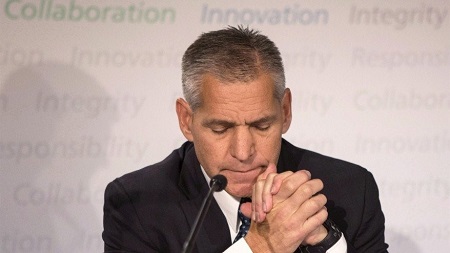Alberta-based TransCanada Corp has shut down its Keystone pipeline after crews spotted oil near a pump station in South Dakota, the company said in a statement on Monday.
The company, Canada`s second largest pipeline operator, said the potential incident was first reported on Saturday afternoon.
TransCanada immediately began the process to shut down the pipeline, activate its emergency response procedures and dispatch ground crews to assess the situation, said the company in a statement. Crews initially found visible signs of oil on a small surface area.
News of the oil seeping to the surface could be inconvenient for TransCanada, which is now trying to convince communities across Canada to accept its proposal for a gigantic new pipeline infrastructure project — the 4,600-kilometre Energy East pipeline.
Leak Discovered by Passerby
The chairman of the South Dakota watchdog, Chris Nelson, confirmed that there was a spill from Keystone, and that state environmental officials were overseeing the cleanup. In a brief phone interview, he told National Observer that a member of the public may have been the one that discovered the spill.
My understanding is that it was a passerby that observed it and called the company, said Nelson, chairman of the South Dakota Public Utilities Commission.
If confirmed, this would mean that the company`s leak detection system failed to identify the incident.
Nelson also said that the company gave the commission an early estimate of the amount of oil that was spilled. But he added that there would not likely be a firm number available until the company digs up and excavates the line.
I`ve seen a particular figure, but I have no idea if it`s accurate or not, Nelson said. Obviously there is an (environmental) impact to the soil where the leak occurred.
In Canada, TransCanada`s proposed Energy East project, expected to generate thousands of construction jobs, would be able to ship more than one million barrels of oil per day from Alberta and Saskatchewan to refineries in Quebec and New Brunswick. The Energy East project would also be designed to allow major new exports of Canadian oil from tankers leaving Atlantic Canada. Energy East is now under review in Canada by the National Energy Board (NEB).
We are quite eager to see how they will try to demonstrate that new pipelines are safe and that we must, as a result, accept, their proposed tarsands export pipeline - Energy East, wrote Quebec Greenpeace campaigner Patrick Bonin, on his Facebook page after learning about the spill.
Keystone is a new pipeline that was approved by the NEB and U.S. regulators before it began commercial operations in June 2010. It was shipping about 500,000 barrels of heavy crude per day from Hardisty, Alberta to Cushing, Oklahoma. The pipeline was expected to be the first phase of the Keystone XL pipeline expansion project that would have eventually linked Alberta`s oilsands producers to refineries on the Gulf coast of Texas. But Keystone XL was rejected by U.S. President Barack Obama last November.
Landowners and local agencies in the area have been notified and we continue to work cooperatively with all parties, said TransCanada. Regulatory agencies have been notified and we are working cooperatively on the investigation.
The company said it would provide regular updates to government agencies as it continues with clean-up efforts near the site in Hutchinson County, South Dakota. The line is expected to remain closed until Friday, CBC News reported.
Keystone customers have been notified the pipeline will remain shut down while TransCanada continues these efforts, added TransCanada in the statement.
The weekend oil spill is not the first incident on Keystone. In Canada, TransCanada reported 21 incidents during the first year of operation, mainly small quantities of oil being spilled near pump stations and later cleaned up.
In the U.S., the federal watchdog for the industry - the Pipeline and Hazardous Materials Safety Administration - alleged that the company had failed to operate Keystone safely after identifying 62 probable deficiencies on the pipeline, including multiple anomalies near St-Louis, Missouri.
One of the affected sections of the line suffered a 97 per cent loss of metal, near the Mississippi River, leaving a remaining wall thickness of 0.012 inches, the U.S. agency had said in a notice.
Meantime, the company said that local residents seeking information in South Dakota could send questions by email to Community_Relations@Transcanada.com or call the company`s community information line at +1 (855) 895–8754.
Photo on front page: A section of the Keystone Pipeline. Source: Sustainable World Coalition. Photo on this page: TransCanada CEO Russ Girling`s company has shut down its Keystone pipeline after crews spotted oil near a pump station in South Dakota. Source: National Observer.














